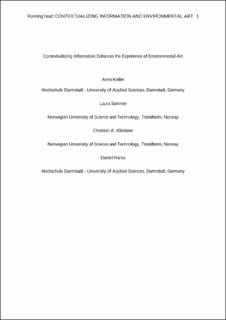| dc.contributor.author | Keller, Anna | |
| dc.contributor.author | Sommer, Laura Kim | |
| dc.contributor.author | Kløckner, Christian | |
| dc.contributor.author | Hanss, Daniel | |
| dc.date.accessioned | 2021-05-12T09:01:56Z | |
| dc.date.available | 2021-05-12T09:01:56Z | |
| dc.date.created | 2020-11-24T12:00:40Z | |
| dc.date.issued | 2020 | |
| dc.identifier.citation | Psychology of Aesthetics, Creativity, and the Arts. 2020, 14 (3), 264-275. | en_US |
| dc.identifier.issn | 1931-3896 | |
| dc.identifier.uri | https://hdl.handle.net/11250/2755125 | |
| dc.description.abstract | Environmentally themed art is increasingly addressed in research as a means to raise awareness of environmental problems and motivate proenvironmental behavior. However, as researchers begin to systematically study environmental art, influencing factors must be addressed—for example, the effect of presenting contextualizing information. In the present study, 123 participants saw an environmental artwork with or without contextualizing information in a between-subjects design and rated the artwork on various variables regarding its aesthetic value and proenvironmental impact. Additionally, eye movement was recorded using mobile eye-tracking glasses to gain insight into the visual processing of the artwork. The results showed that information presentation increased personal meaning, which was in turn associated with increased liking, interest, and emotional responses. The average duration of fixations was shorter for participants in the information group, indicating easier processing possibly due to the guidance of the provided information. However, information had no effects on participants’ proenvironmental intentions and behavior. Taken together, the results strongly suggest that both researchers and practitioners should be taking the effect of contextualizing information into account when exhibiting environmental art, because it can impact a variety of relevant factors. | en_US |
| dc.language.iso | eng | en_US |
| dc.publisher | American Psychological Association | en_US |
| dc.title | Contextualizing information enhances the experience of environmental art | en_US |
| dc.type | Peer reviewed | en_US |
| dc.type | Journal article | en_US |
| dc.description.version | acceptedVersion | en_US |
| dc.source.pagenumber | 264-275 | en_US |
| dc.source.volume | 14 | en_US |
| dc.source.journal | Psychology of Aesthetics, Creativity, and the Arts | en_US |
| dc.source.issue | 3 | en_US |
| dc.identifier.doi | 10.1037/aca0000213 | |
| dc.identifier.cristin | 1851574 | |
| dc.description.localcode | © American Psychological Association, 2020. This paper is not the copy of record and may not exactly replicate the authoritative document published in the APA journal. Please do not copy or cite without author's permission. The final article is available, upon publication, at: https://doi.apa.org/doi/10.1037/aca0000213 | en_US |
| cristin.ispublished | true | |
| cristin.fulltext | postprint | |
| cristin.qualitycode | 1 | |
